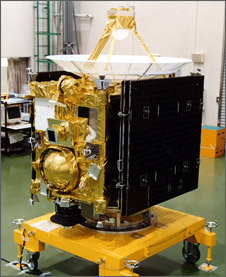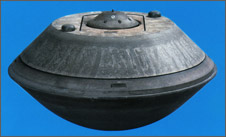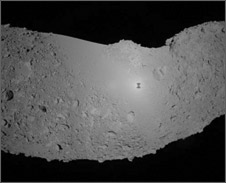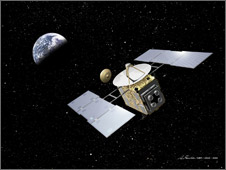

Hayabusa left the asteroid Itokawa this past April. Its Earth return capsule will be retrieved in the Woomera desert in Australia three years from now, in 2010, after it is detached from the mothership and reenters the Earth's atmosphere. The maximum flux of aerodynamic heating on the capsule at reentry will be tens of times greater than that experienced by a space shuttle, and the technology used to make its heat-resistant material is cutting edge. Retrieval of the capsule on Earth is one of the major objectives of the Hayabusa project, but at the same time the success of the return flight from the asteroid to Earth, that is a round-trip to a celestial body, is also a priority. Although the project team was able to revive the explorer after a malfunction, it is still not in a healthy condition. Challenges for the Hayabusa project team will continue until the spacecraft returns to Earth.
Q. What is the main challenge in Hayabusa's return to Earth?

Asteroid explorer Hayabusa
When the Earth return capsule reaches the atmosphere, the temperature on its surface will reach an estimated 3000ºC, due to aerodynamic heating. The capsule must withstand the heat. The capsule, which is 40 cm in diameter, will enter the atmosphere from its interplanetary orbit at more than 12 km per second. The speed of a space shuttle entering the atmosphere is nowhere near as high as this; because of the differences in shape, size and speed, Hayabusa has to endure 30 times more aerodynamic heat than the shuttle.
For an object entering the atmosphere, the steeper its angle to the horizon the greater the maximum aerodynamic heating. The shallower the angle, the longer the travel takes, but that amplifies the total overall heat input. To protect Itokawa's sample and the spacecraft's interior, Hayabusa is designed to reenter the atmosphere from a relatively steep angle, so the total heat input can be as low as possible within the endurance ability of the heat resistant material (ablator). Reentering the atmosphere at a steep angle also has merit in narrowing the estimated landing dispersion range. We tested and developed the capsule's heat resistant material at the arc-heated wind tunnel at ISAS/JAXA, and the performance of the material has also been tested and confirmed with larger test pieces using NASA's larger-scale facilities.
Q. Could you tell us about international cooperation around the Hayabusa project?

Earth return capsule
We have established cooperative systems primarily with NASA, as well as with Australia and other countries, for such things as research on heat-resistant material, observation of the asteroid Itokawa with ground telescope and radar prior to launch, and data receiving and tracking operation using deep space networks with large antennae. When Hayabusa landed on Itokawa, we actually operated it by switching between antennae, one at the Usuda Deep Space Center (UDSC)/JAXA in Japan and another at Goldstone in the United States. Also, a joint team will be formed to analyze the samples from the asteroid. Such international collaboration is necessary for many reasons. In a broad sense, we believe that the results of space science should be shared among all humankind. To do so, I think that we scientists and engineers must practice international cooperation.
Q. What is the main challenge of the Hayabusa operation?

Command room for Hayabusa
There are some, but I think the unique issue of a planetary probe's operation is keeping track of two different clocks - Earth time and the explorer's time - at all times. These two times were always indicated side by side on a white board in the operation room. Back and forth communication between the ground and the spacecraft takes about 40 minutes because Itokawa was 300 million kilometers away from us. So, if action is taken based on the information we have just received, it may already be too late. You have to take into account that the information that has just come in is already old, and you must give a command trying to foresee what will happen next. This is one challenge of remote operation.
Q. What is your most vivid memory of Hayabusa operations thus far?

An image of Itokawa taken prior to Hayabusa's second landing. Hayabusa's shadow is seen.
One of them is Hayabusa's second landing. I felt very confident about it. Take-off from the surface after the landing went smoothly. The explorer lifted off without losing attitude and all data were reading correctly. We also confirmed that the spacecraft received the command to fire a bullet to collect samples during landing. Unfortunately, we later learned that there is a possibility that the bullet was not shot, but it was still a great moment to find that the scenario for landing went as planned. So the news about a subsequent fuel leak was very shocking and disappointing to us.
The other operation I strongly recall is the separation of Minerva during descent rehearsal prior to landing. Minerva is a rover designed to land on and survey the surface of the asteroid before Hayabusa's landing. We ended up releasing the rover even though we weren't so sure of the performance of the landing sensor. Hayabusa descends measuring the distance between itself and Itokawa with an on-board laser altimeter (LIDAR) and Laser Range Finder (LRF). LIDAR is used for determining greater distance, and LRF is used for short distances, of 100 meters or less. We needed to adjust LRF performance and threshold during the rehearsal, as the surface of the asteroid was brighter than expected. So the instrument was not available because we were in the middle of tuning it. As a result, although we thought we had ejected Minerva at an altitude of 70 meters, it was actually separated at an altitude of 200 meters. And not only that, the rover could not touch the asteroid because the explorer was in climb mode. We intended to avoid releasing Minerva during landing as it would complicate the operation, but in the end, I regret to say that we ended up conducting such a difficult remote operation despite our inexperienced distance management. It was a really difficult and unsatisfying operation. This is the operation I recall most clearly.
Q. Did your impressions of Itokawa change after Hayabusa's arrival?

Asteroid Itokawa
We had imagined Itokawa to be full of craters and covered with fine sand (regolith) like the lunar surface, and that turned out to be completely wrong. We found there to be many naked rocks and boulders, but no sand at all. Hayabusa's sample collector was designed on the assumption that the surface of Itokawa was much smoother, so we were worried whether it would work properly on such a rocky surface. On the other hand, we had guessed that the surface had gravel studded with a mix of sand and small stones, and this theory appears to be right. It is another great achievement to have been able to measure the size of the grains.
Q. As the project manager how do you feel about the Hayabusa team?
I was only in my thirties when the Hayabusa project started. Everyone else on the team was also young at that time. What makes our team special is that each member has been using their originality and creativity since the beginning of the development stage, and it's not at all like a project where the staffs are working out of duty or obligation. When there is a problem, everyone tries to come up with a solution. There is a culture on our team where everyone thinks and creates proactively. We have been able to get over any difficulties thus far thanks to everyone's hard work and our teamwork. I am very proud of this.
Q. What do you think is the key to managing a project team?
As far as the Hayabusa project is concerned, each participating member is very motivated and has been working with impressive initiative. Of course, I give instructions for running the overall project, but everyone understands their own task and position well, so they know what to do next. So I didn't have much trouble with staff management. I think that a project takes a combination of passion and patience to try new things, an ability to make decisions, and steadiness to make progress little by little, with great care.
Q. What have you learned through your experience with the Hayabusa mission?
I think the most important thing is creativity - not repeating the same way of doing things but finding completely new methods. I have also realized that the great enjoyment of doing science and technology is to demonstrate them.
Q. How would you like to see the achievements of Hayabusa utilized?
It usually takes almost 10 years to develop a space project. In the case of a planetary probe, it sometimes takes much longer than that from beginning to end, because it takes several years for the spacecraft to arrive at the destination after launch. I am very honored to have participated in a space development project like Hayabusa from its concept stage, and to have watched my ideas coming to real. Today's trend is to put all the weight on reliability and credibility and safe. But in those days, we were able to get approval for the mission even though it was recognized as quite challenging. I hope that the originality of Hayabusa will contribute to Japan's progress in science and technology, and in a broad way to its cultural evolution. Japan sometimes seems satisfied to be the second best, but I'd like to let our young people know that there is a world where people are working on something nobody has ever thought of before.
Also, I believe that the age of exploration of the solar system will come when people can travel freely and arbitrarily in space. People will be going around the Earth and the Moon, or Mars, or other planets. The purpose of these activities will vary from resource utilization to staying in space to conduct observation, and I think that flight with electric propulsion systems, such as ion engines, which were adopted for Hayabusa, will allow this to happen. Establishing the reliability of the technology will allow us to broaden the range of our activities. I hope that Hayabusa will lead to an era of frequent round-trip space flights.
Q. Do you have a message for children who wish to be involved in future space development?
The Japanese word for future is literally “what has not come yet.” You cannot see the future, but trying to make the future visible is important. It's not about memorizing things. I think the most important thing is not to become a professional learner but to make efforts to create what has not come yet, and to make it tangible.
Q. What do you think about Hayabusa's return to Earth?

Hayabusa releasing the Earth return capsule (artist's rendition by A. Ikeshita and JAXA/ISAS)
Two of Hayabusa's three attitude control devices (reaction wheels) were lost due to malfunction before arrival on Itokawa. Additionally, there was a fuel leak after taking off from the surface of the asteroid, and as a result, chemical fuel on board was almost all discharged or resulted in not-available. But, fortunately, we were able to use the ion engine and xenon gas thruster without problems, so we devised a new attitude control method using these tools. We had previously prepared for departure, for example, by testing the ion engines, recharging lithium-ion batteries, and operating attitude control to head in the direction of the Sun, which is a way of changing the spacecraft's attitude using the subtle pressure of solar light, making the use of xenon gas unnecessarily. Having missed the window for a quick return to Earth, we've had to extend Hayabusa's cruise by three years. I'd like to make the utmost efforts to bring Hayabusa home with the use of the surviving functions.
Doctor of Engineering. Principal and Professor of the Research Division of Space Systems Engineering at the Institute of Space and Astronautical Science (ISAS)/JAXA.
In 1983, Dr. Kawaguchi graduated from the Department of Aeronautics, School of Engineering, at the University of Tokyo. He became an assistant professor at the Systems Research Division at ISAS in the same year, and a full professor in 2000. Dr. Kawaguchi is also the program director of the JAXA Space Exploration Center. He specializes in control systems theory and astrodynamics (applied flight dynamics).







